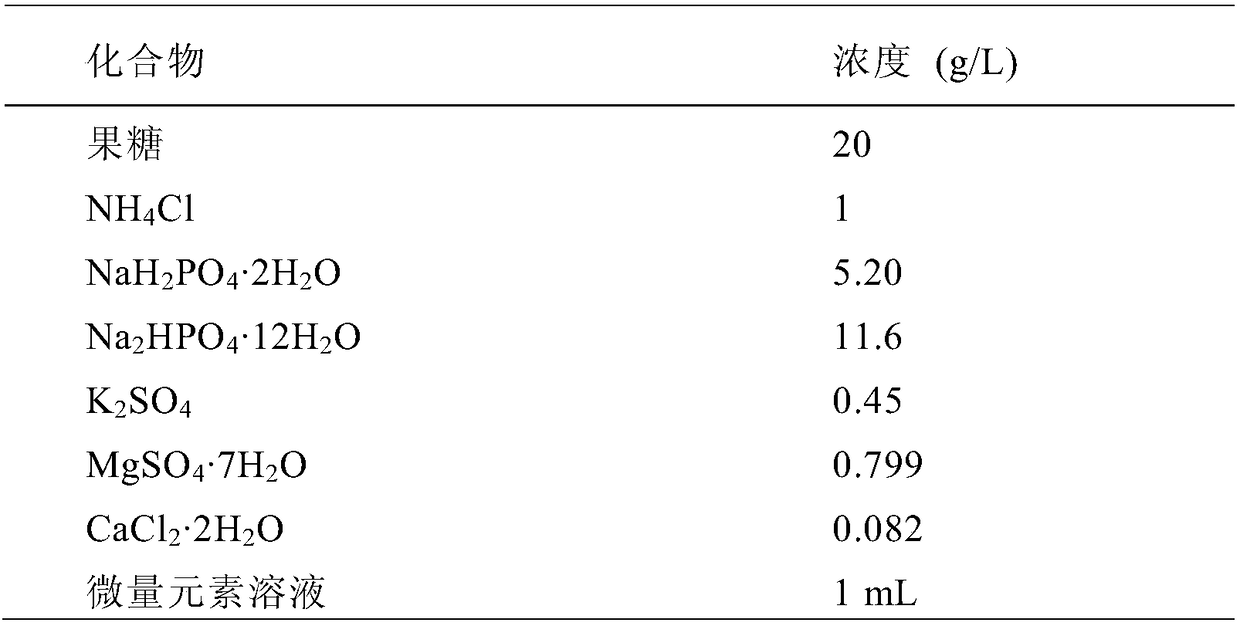Method for improving yield of PHB produced by Ralstonia eutropha by optical driving
An Alcaligenes eutropha, light-driven technology, applied in microorganism-based methods, biochemical equipment and methods, microorganisms, etc., can solve problems such as insufficient understanding of microbial nutritional needs, increased production costs, and low success probability. Achieve the effect of promoting growth and production capacity, increasing yield, and low cost
- Summary
- Abstract
- Description
- Claims
- Application Information
AI Technical Summary
Problems solved by technology
Method used
Image
Examples
Embodiment 1
[0031] Utilize CdS to improve the amount of poly-beta-hydroxybutyrate (PHB) produced by Ralstonia eutropha (Bei Na Biology, BNCC137386), the steps are as follows:
[0032] (1) Preparation of CdS
[0033] Prepare 35 mL each of 0.2 mol / L cadmium nitrate and 0.2 mol / L sodium sulfide solution, add the sodium sulfide solution dropwise into the cadmium nitrate solution under stirring conditions, and after stirring for 2 hours, put the mixed solution into polytetrafluoroethylene In an ethylene reactor, gradually raise the temperature to 200°C and keep it warm for 6 hours. After the reaction was completed, it was naturally cooled to room temperature, and the obtained precipitate was suction-filtered, washed, and dried at 55° C. to obtain a yellow CdS powder.
[0034] (2) Microbial culture
[0035] The strains stored in the freeze-drying tube were activated in the seed medium. After Ralstonia eutropha grew for 24 hours, the obtained bacterial solution was inserted into the basic medi...
Embodiment 2
[0040] Using CdS / Cd(OH) 2 To increase the amount of poly-β-hydroxybutyrate (PHB) produced by R.eutropha, the steps are as follows:
[0041] (1) CdS / Cd(OH) 2 Preparation of Composite Photocatalyst
[0042] Weigh 8.3291g NaOH dissolved in 40mL deionized water, measure 10mL triethanolamine dissolved in NaOH solution, weigh 0.4574g CdCl 2 2.5H 2 O was dissolved in 10mL deionized water, and then weighed 0.4926g Na 2 S·2H 2 O dissolved in 10 mL deionized water, CdCl 2 Add the solution to the mixed solution of triethanolamine and NaOH, stir evenly, then add NaOH dropwise to the mixed solution 2 After stirring the S solution evenly, put the mixed solution into a polytetrafluoroethylene reactor, gradually raise the temperature to 180°C, and keep the temperature for 12h. After the reaction, cool down to room temperature naturally, filter the obtained precipitate, wash it, and dry it at 55°C to obtain CdS / Cd(OH) 2 composite photocatalyst.
[0043] (2) Microbial culture
[0044]...
Embodiment 3
[0049] Use g-C 3 N 4 To increase the amount of poly-β-hydroxybutyrate (PHB) produced by Ralstonia eutropha, the steps are as follows:
[0050] (1) g-C 3 N 4 preparation of
[0051] Weigh 10g of urea, dry it at 55°C, move it to a muffle furnace for 2 hours at 550°C, and cool it down to room temperature naturally after the reaction, filter and wash the obtained precipitate, and dry it at 55°C to obtain Yellow g-C 3 N 4 powder.
[0052] (2) Microbial culture
[0053] The strains stored in the freeze-drying tube were activated in the seed medium. After Ralstonia eutropha grew for 24 hours, the obtained bacterial solution was inserted into the basic medium I for expansion and cultivation until the od value was 1, and the same amount of bacterial solution was transferred to To two groups of basal medium, one of which added g-C 3 N 4 (Concentration is 1g / L), another group does not add anything, cultures in Erlenmeyer flask at 30°C, 200 rpm for 84h, the medium volume of each...
PUM
| Property | Measurement | Unit |
|---|---|---|
| concentration | aaaaa | aaaaa |
Abstract
Description
Claims
Application Information
 Login to View More
Login to View More - R&D
- Intellectual Property
- Life Sciences
- Materials
- Tech Scout
- Unparalleled Data Quality
- Higher Quality Content
- 60% Fewer Hallucinations
Browse by: Latest US Patents, China's latest patents, Technical Efficacy Thesaurus, Application Domain, Technology Topic, Popular Technical Reports.
© 2025 PatSnap. All rights reserved.Legal|Privacy policy|Modern Slavery Act Transparency Statement|Sitemap|About US| Contact US: help@patsnap.com



